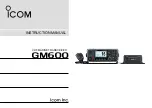
Link XP L2102/L2104 Receiver Instruction Manual Issue 1 - October 2003 Page 27 of 48
Link Research Ltd. 23/24 Watford Metro Centre, Dwight Road, Watford, Hertfordshire, WD18 9XA, England. Tel: +44 (0) 1923 200 900
Registered in London No. 2074604
Web:
www.linkres.co.uk Fax: +44 (0) 1923 241 357
L2102 & L2104 Receiver
Instruction Manual
2.2
Cables
2.2.1
Why should I be concerned about cables?
Wireless camera systems use very low power transmissions with a maximum effective
radiated power of around 100mW. To make the most of this, it is vital that the correct
cable types are used and that they are treated with respect. A damaged cable of the
correct type may give inferior performance to good cable of the wrong type and both will
provide less than acceptable results.
2.2.2 Cable
impedances
Two different cable impedances are used in wireless camera systems. The transmit system
will use 50
Ω
coaxial cable and the receive system will use 75
Ω
cable. It is vital that the
two cable types are not mixed up or system performance may be disappointing.
As supplied, Link receivers do not require the use of any 50
Ω
cable because the connection
between the receive antenna and the down convertor is made by using N-type elbow
connectors. However, if these are lost or become damaged, a short 50
Ω
coaxial link with
N-type connectors can be made up. The length of this link should not excede15cm to avoid
unnecessary signal losses.
2.2.3 Cable
losses
Figure 33 – Link
omnidirectional receive
antenna mounted on L3010
down convertor
















































